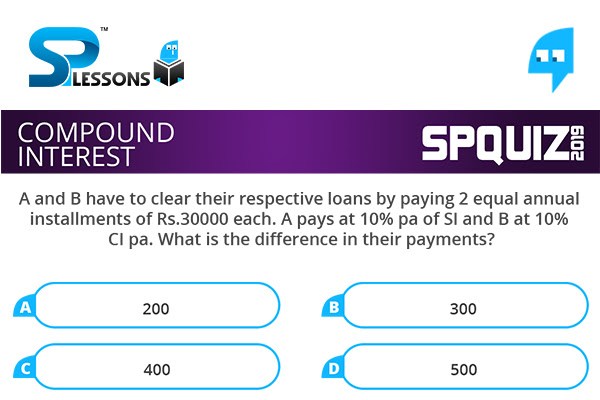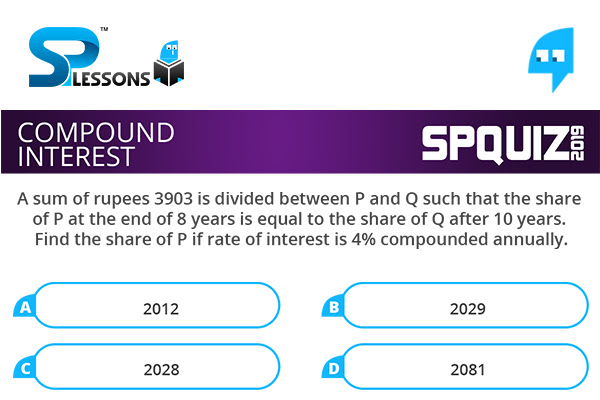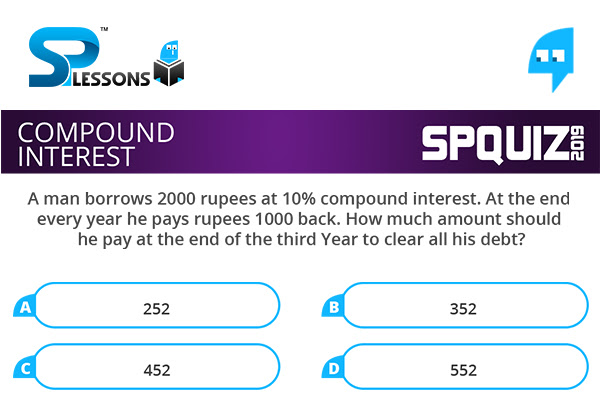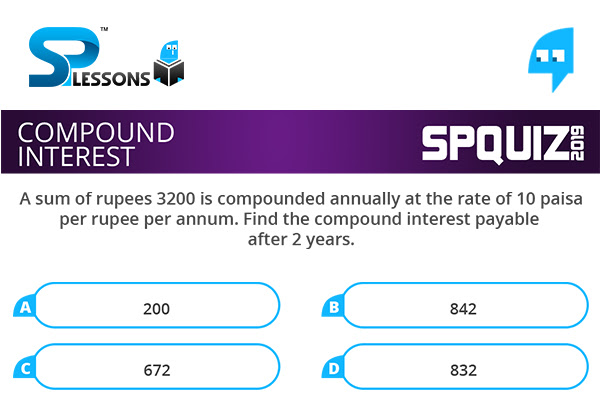 Introduction
Introduction
What is compound interest?
Compound interest is the addition of interest to the principal sum of a loan or deposit, or in other words, interest on interest. It is the result of reinvesting interest, rather than paying it out, so that interest in the next period is then earned on the principal sum plus previously accumulated interest.
Compound Interest is one of important topic in Quantitative Aptitude Section. In Compound Interest Quiz 7 article candidates can find questions with answer. By solving this questions candidates can improve and maintain, speed, and accuracy in the exams. Compound Interest Quiz 7 questions are very useful for different exams such as IBPS PO, Clerk, SSC CGL, SBI PO, NIACL Assistant, NICL AO, IBPS SO, RRB, Railways, Civil Services etc.
 Q1
Q1
A and B have to clear their respective loans by paying 2 equal annual installments of Rs.30000 each. A pays at 10% pa of SI and B at 10% CI pa. What is the difference in their payments ?
- A. 200
B. 300
C. 400
D. 500
D = [latex][(30000 \times \frac {110}{100} \times \frac {110}{100}) - 30000] -30000 \times 10 \times \frac {2}{100}[/latex]
= [36300 - 30000]- 6000
= 6300 – 6000
D = 300
 Q2
Q2
The difference between interest received by Vivek and Vimal is Rs.405 on Rs.4500 for 3 years. What is the difference in rate of interest ?
- A. 1.5%
B. 2%
C. 3%
D. 2.7%
[latex]4500 \times \frac {3}{100} ({R}_{1} - {R}_{2}) = 405[/latex]
[latex]{R}_{1} - {R}_{2} = 405 \times \frac {100}{13500} = 3 [/latex] %
 Q3
Q3
A sum of rupees 3903 is divided between P and Q such that the share of P at the end of 8 years is equal to the share of Q after 10 years. Find the share of P if rate of interest is 4% compounded annually.
- A. 2012
B. 2029
C. 2028
D. 2081
[latex]P \times {(1 + \frac {4}{100})}^{8} = (3903 – P) \times {(1 + \frac {4}{100})}^{10}[/latex] = 2028
 Q4
Q4
A man borrows 2000 rupees at 10% compound interest. At the end every year he pays rupees 1000 back. How much amount should he pay at the end of the third Year to clear all his debt?
- A. 252
B. 352
C. 452
D. 552
After one year amount = [latex]2000 \times \frac {110}{100} = 2200[/latex]
He pays 1000 back, so remaining = 2200 – 1000 = 1200
After second year = [latex]1200 \times \frac {110}{100} = 1320[/latex]
He pays 1000 back, so remaining = 1320 – 1000 = 320
After third year = [latex]320 \times \frac {110}{100} = 352[/latex]
 Q5
Q5
A sum of rupees 3200 is compounded annually at the rate of 10 paisa per rupee per annum. Find the compound interest payable after 2 years.
- A. 200
B. 842
C. 672
D. 832
Rate of interest is 10 paisa per rupee per annum. So for 100 rupees it is 1000 paise i.e. 10 percent
Now, CI = [latex]3200 {(1 + \frac {10}{100})}^{2} -3200 = 672[/latex]








